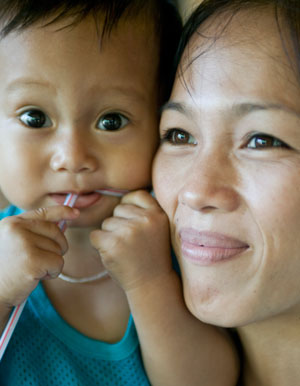With Australia's help, Cambodia has halved the number of women who die in childbirth or pregnancy each year.
The cut in maternal mortality between 2005 and 2010 means more than 900 women now live rather than die each year.
However, the mortality rate of 206 deaths in every 100,000 live births in 2010 is still about 25 times greater than Australia's maternal mortality rate.
Helping Cambodia continue to lower maternal mortality and improve the reach and quality of health care is a pillar of Australia's aid program in Cambodia.
The approach to saving lives
The Cambodian Government, Australia and other donors are tackling the 'three delays' that cost the lives of mothers and babies:
- Delays in seeking care. Women are provided information about family planning, health facilities, obstetric and midwifery care, nutrition, family planning, ante and post natal care. This includes educating the family 'gatekeepers' and decision makers who influence when and how women seek care.
- Delays in getting to care. Health centres and hospitals and the roads that lead to them are being improved and affordable transport made available so women can get to facilities.
- Delays in receiving care. Health services are being improved to provide women access to drugs, equipment and skilled birth attendants such as midwives.
How Australia helps
Between March 2007 and June 2012, Australia provided $46.6 million in health sector support to Cambodia, mainly targeted at maternal and child health and improving the access of poor and vulnerable people to good quality and affordable health care.
Australia helps to get services closer to poor people across the country by helping fund, through Cambodia's health system, hospital and health centre construction and renovation and new medical equipment.
With the World Health Organisation, Australia helps Cambodia's health services plan how many doctors, nurses, midwives and administrators hospitals need, and train them. Australia also provides some additional funds to non-government organisations to fill immediate skills gaps and help train local Cambodians.
Australia has supported a system to make sure that poor people can access health services for free. It provides incentives for hospitals and clinics that treat the poor and a card for poor people to get free healthcare. Around three quarters of people living under the poverty line now have access to free health care.
Trained midwives are one of the key factors in saving the lives of women in childbirth. AusAID supports Australian Volunteers International to place seven Australian volunteer midwives in hospitals and health centres to mentor and coach Cambodian midwife educators to enhance the training curriculum.
Australia has also supported a national exam process for health workers to ensure all licensed health workers are sufficiently trained and licensed to practice.
Australian non-government organisations have long relationships with communities across Cambodia. Australia supports them to share the importance of family planning, neonatal care and after care.
Progress in numbers
Between 2005 and 2010 Cambodia halved maternal mortality, from 472 to 206 deaths per 100,000 live births. In the same period infant mortality fell from 66 to 45 deaths per 1000 live births. The reductions saved lives and exceeded Cambodia's Millennium Development Goals for maternal and infant mortality.
In 2011:
- 71 per cent of births were attended by trained health staff, up from 44 per cent in 2006
- 89 per cent of women who gave birth to live babies received antenatal care from a professional in 2010, compared to 69 per cent in 2005
- 54 per cent of women gave birth in a health facility in 2010, compared to 22 per cent in 2005
- 77 per cent of people living under the poverty line were protected by Health Equity Funds supported through Australian funding.
In 2012, Australia will help Cambodia to ensure three quarters of all births are attended by trained health staff, nine out of every 10 pregnant women receive ante-natal care and 85 per cent of the population has access to affordable health care.
Working with non-government organisations (NGOs)
'Window of opportunity' to save children
Despite Cambodia's impressive accomplishments in maternal health, malnutrition remains a serious problem. Nearly 40 per cent of Cambodian children under the age of five are short for their age, according to the 2010 Cambodia Demographic and Health Survey – one of the highest rates in the region.
The first 1000 days, from the beginning of pregnancy to a child's second birthday, are considered a critical "window of opportunity" during which poor nutrition can result in stunted growth, diminished immune response, impaired intellectual ability, poor school performance and lower economic productivity.
Australia and partners including The World Bank and the United Kingdom are working through the Second Health Sector Support Program to distribute vitamin A and implement communication campaigns to promote improved child-feeding practices.
More information
In 2012, Australia is working with three NGOs to design a joint program of preventative health and family planning initiatives that will work to save lives by reducing the delays in women seeking care.
CARE Australia, Save the Children Australia and Marie Stopes International Australia were chosen for the partnership for their strong connections and lengthy experiences in maternal health and the respect and goodwill of communities and women in Cambodia.
The partnership will help the Cambodian Government implement its Fast Track Initiative Road Map which identifies seven areas to save more lives including scaling up NGO-led preventative health and family planning initiatives that are proven to work.

